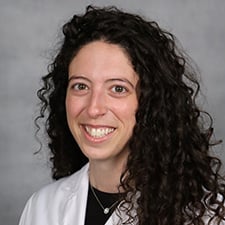When the days grow shorter and temperatures drop, millions of people find themselves grappling with the “winter blues.” This is known as seasonal affective disorder, which is a form of depression that follows a seasonal pattern. Emerging primarily during the fall and winter months when sunlight exposure decreases and clocks fall back, seasonal affective disorder can take a toll on a person’s daily life. Knowing what to keep in mind and when to seek help can make all the difference during fall and winter months.
The AMA’s What Doctors Wish Patients Knew™ series gives physicians a platform to share what they want patients to understand about today’s health care headlines.
For this installment, two AMA members took time to discuss what patients need to know about seasonal affective disorder. They are:
- Adrian Jaques H. Ambrose, MD, MPH, a pediatric neurointerventional psychiatrist in New York, New York.
- Andrea DeSimone, DO, a psychiatrist and chair of the psychiatry department at Bayhealth Medical Center in Dover, Delaware.
Bayhealth is part of the AMA Health System Member Program, which provides enterprise solutions to equip leadership, physicians and care teams with resources to help drive the future of medicine.
It happens in a seasonal pattern
While this is “technically not a real name, seasonal affective disorder—or very appropriately initialized as SAD—is a subtype of major depressive disorder,” Dr. Ambrose said. “It’s characterized by recurrent episodes of depression that happen in a seasonal pattern, so generally when there is a reduced exposure to natural sunlight.”
“Seasonal affective disorder occurs during certain times of the year, typically in the fall or winter months when there's less sunlight,” Dr. DeSimone said in a video interview. “And occasionally, people can have worsening of mood symptoms in the summer months, but that's much less common.”
“In the Northern hemisphere, it’s generally during the fall and winter months,” Dr. Ambrose said, noting “people historically have called it the winter blues.”
The official name from the Diagnostic and Statistical Manual of Mental Disorders, Fifth Edition, Text Revision (DSM-5-TR), published by the American Psychiatric Association, “is still just major depressive disorder and the subcategory is with seasonal pattern,” he said.
Symptoms are similar to depression
“To meet the criteria for seasonal affective disorder, you much first meet the criteria for major depressive disorder, which, again, is having five of nine symptoms plus anhedonia, which is that loss of pleasure for at least two weeks,” said Dr. DeSimone.
Since seasonal affective disorder is “a subcategory of major depressive disorder, you see a lot of the common symptoms within the two categories,” Dr. Ambrose said. This includes “persistent sadness or low moods, and loss of interest or pleasure in activities.”
Additionally, “there’s a disruption in sleep patterns that are maladaptive—either you’re under sleeping or oversleeping, changes in your appetite and weight,” he said. “Oftentimes you see this trend for people to almost ‘hibernate,’ so there are increased cravings for carbohydrate rich foods and a lot of snacking.”
In turn, “people tend to gain more weight, have decreased energy and activity overall, and reports of fatigue and difficulty concentrating,” Dr. Ambrose said. “On the most intense and severe side, you have these increased feelings of the hopelessness, worthlessness and an increase in suicidality in extreme cases.
“So, it’s thought to be a depressive episode that’s triggered due to the disruption in the body’s natural circadian rhythm and the changes in neurotransmitter levels. And it’s less common in the summer months, but it can happen,” he added.
Ultimately, “seasonal affective disorder is depression that occurs during certain times of the year and then resolves,” said Dr. DeSimone. “This cycle must occur for two years to meet criteria for the specific type of major depressive disorder.”
Seasonal affective disorder is common
“It’s relatively common, depending on the severity of the individuals who may be experiencing seasonal affective disorder,” Dr. Ambrose said. “One of the reasons why they believe that it’s likely related to the reduced sunlight exposure during the winter months is because the prevalence of reported seasonal affective disorder tends to vary based on geographical location.
“So, in places where the days are generally shorter, it’s reported to have a higher prevalence,” he added, noting “you see places at higher latitudes like the Scandinavian countries there tends to be higher prevalence of seasonal affective disorders.”
“Some of the epidemiologic studies in the U.S. suggests that about 5% of adults will experience some version of seasonal affective disorder,” Dr. Ambrose said. “And the really interesting part is up to one in five additional U.S. adults will have some neurovegetative symptoms of seasonal affective disorder that may not fully meet the criteria for the full disorder. Instead of the full spectrum of symptoms, they’ll have some decreased energy.
“They may have some disruption of sleep and they may have some decreased concentration, but they may not necessarily have appetite changes. They may not necessarily have weight gain,” he added.
There are some theories why
While “we don’t fully know, some of the theories behind seasonal affective disorder or major depressive disorder with seasonal patterns is it’s linked to the reduced sunlight exposure and circadian rhythm disruption during the winter months,” Dr. Ambrose said.
Additionally, “it’s a combination of the circadian rhythm and the serotonergic and melatonin imbalance that we generally see during the shifting of the sunlight exposure because they both play really important roles in mood regulation and sleep,” he said.
Social isolation may occur
“Social isolation tends to coincide with a lot of the neurovegetative symptoms,” Dr. Ambrose said. That means “you have reduced interest or pleasure in activities and you have low energy and more fatigue.”
As a result, “you are more likely to socially isolate because you don’t want to do anything, you don’t want to interact with other people and it compounds on itself,” he said.
Winter months are particularly hard
“Generally, the worst months—from incidental findings of patients in our ambulatory clinics—tend to be escalating around December, January, February,” Dr. Ambrose said. “And this is where I want to be mindful not to attribute anything, but some theories are this is when you have the least amount of daylight during the winter months.
“This is also when people are able to get care because the holidays and actually having some time off and you are around your family—there are more people to encourage you to get care,” he added. “If you think about right around December that’s when a lot of businesses close, so there’s an increased level of stress that people endure as well.”
It can happen in the summer too
Seasonal affective disorder doesn’t just happen during winter months. It can also happen in the summer.
“In the literature, they’ve described this phenomenon: the summer seasonal affective disorder,” Dr. Ambrose said. “It’s much less common in comparison to the fall and winter, but the summer seasonal affective disorder we generally see more activating symptoms. So, more anxiety, more insomnia and worsened appetite.”
“This is where it’s very important to have this conversation with your psychiatrist because if you have this recurrent pattern—and the key here is the recurrent patterns of episodes because it could be a major depressive disorder—this is where treatment planning could be very helpful,” he said. “So, instead of waiting until you decompensate into a full-blown depressive episode, this is where you can work with your psychiatrist to proactively plan either engaging in augmenting treatment or managing your psychopharmacology to create some stabilization.”
Duration of episodes varies
“For the most part, the durations of the seasonal affective disorder symptoms can also vary if they are directly linked to this theory of decreased sunlight exposure or disruption in the regular circadian rhythm,” Dr. Ambrose said. “With appropriate treatment, oftentimes symptoms can resolve within weeks or months, but the caveat here is if you have depressive symptoms during the winter months, it doesn’t always mean that you have seasonal affective disorder.
“It could just be coincidentally that you have a major depressive disorder during the winter times,” he added. “I stress this because patients oftentimes will be really frustrated that they have a depressive episode during the winter months and it’s springtime and they still haven’t gotten better.”
That’s because “it may not necessarily be seasonal affective disorder,” Dr. Ambrose said. “The etiology, the root cause behind your symptoms, may not necessarily be the circadian rhythm changes or the reduced light exposure. In which case, having the days be longer in the spring may not be as helpful to you.”
Every adult should be screened
“Depression can be invisible, so the first thing to do is to ask about it. In 2023, the United States Preventive Services Task Force recommended that all adults 18 years and older be screened for [major depressive disorder] at least once in their life,” said Dr. DeSimone. “This can be done using a variety of freely available screening instruments.”
“This can include the Patient Health Questionnaire, which is the PHQ9, or the Geriatric Depression Scale,” she said, noting “there's no recommendation on how often to screen patients for depression.”
“Now, this recommendation wasn't specifically made for primary care doctors, meaning even subspecialty offices can screen patients,” said Dr. DeSimone. “These patients may be going to see their specialist, but not a primary care doctor. So, it's important to keep in mind that while a subspecialist may not be an expert in treating depression, that doesn't mean that they can't be supportive to a patient who's in need.
“Many times, patients with [major depressive disorder] feel very alone, and that connection with someone who values them enough to take the time to ask about their mental health can be, quite literally, lifesaving,” she added.
Don’t try to diagnose yourself
Seasonal affective disorder “is diagnosed through conversations with your physician. As with any other psychiatric diagnosis, it’s through a comprehensive clinical evaluation by a psychiatrist,” Dr. Ambrose said. “And the reason I really want to underscore this for patients is because from the patient’s perspective it could just be seasonal affective disorder.”
“Oftentimes when I interview patients, I’ll find out that it’s actually compounded. Either there will be very atypical presentations or there’ll be additional comorbidities that a patient may not necessarily think about,” he said, noting “there are no specific laboratory tests for diagnosing seasonal affective disorder. It’s a clinical diagnosis.”
“I don’t want patients to stress out trying to figure out their own diagnosis. It’s more of how you work together with your physician so you can better understand any potential contributing factors, some clarity for your diagnosis and, most importantly, treatment planning,” Dr. Ambrose said.
Psychotherapy is effective
“Medications are not necessarily the answer to all cases of major depressive disorder,” said Dr. DeSimone. “I know it can be super challenging to get in to see a psychotherapist.
But psychotherapy can work wonders for patients with” depression or seasonal affective disorder, she added.
Light therapy can help
One of the more common methods for treating seasonal affective disorder “is using photo therapies or light therapy in which individuals are exposed to bright white lights,” Dr. Ambrose said, emphasizing “it has to be ‘white lights.’ It’s the natural light exposure that you theoretically would get and what you’re trying to do is to mirror the normal circadian rhythm that you typically would get.”
Additionally, “you would want to have this light exposure first thing in the morning. You don’t want to do it at night because that’s when it disrupts your sleep pattern,” he said. There is also “some evidence that cognitive behavioral therapy can really help patients throughout this period.”
Make appropriate lifestyle changes
“While there is no sure way to prevent depression, there are absolutely some steps that patients can take to maintain a healthy lifestyle, which has been shown to impact mental health in a positive way,” said Dr. DeSimone. “First, a balanced diet rich in fruits and vegetables, whole grains, unprocessed foods can help reduce the risk of depression and may even support recovery for those already struggling with it.
“But there’s no strong evidence that any particular diet, such as a ketogenic diet, gluten-free diet, vegan diet, Mediterranean diet, is more effective in treating major depressive disorder than any others,” she added. “We do know that maintaining a healthy weight is associated with a lower risk of developing depression.”
“Some of the other non-pharmacologic interventions also are the traditional lifestyle adjustments that we often talk about,” Dr. Ambrose said. Those include “sleep hygiene, stress management, physical activity and exercise.”
“In terms of exercise, any physical activity is beneficial, but research suggests that activities like walking, jogging, yoga and strength training are especially effective for this,” Dr. DeSimone said.
Also, when possible, “increasing outdoor activities so you can maximize your exposure to natural daylight during the day,” said Dr. Ambrose.

There are medication options
“For medications or pharmacologic options, it’s typically a component of both,” Dr. Ambrose said. “For the most part that means the antidepressants. And in certain situations, vitamin D supplementation can be helpful for patients who struggle with seasonal affective disorder because it tends to run as a comorbid condition.”
“A lot of time, especially during the winter months, patients say they feel really tired, don’t have a lot of energy and have this really low mood,” he said. That’s when “I’ll often check the vitamin D level. Half the time it’s quite low.”
But it is important to “have this conversation with your psychiatrist because you don’t want to just randomly take vitamin D supplementation,” Dr. Ambrose said. “That can potentially be maladaptive and harmful if it builds up in your system over time.”
It can take two weeks to respond to an antidepressant
“Part of the art of psychiatry is to know when a patient is at an appropriate dose for them,” said Dr. DeSimone, noting that “when we start an antidepressant, we expect the patient to take about two weeks to respond in some way to an antidepressant.
“So, at the beginning of a titration of an antidepressant, I'm not expecting them to have a resolution of their depression within two weeks,” she added. “I'm expecting them to have some kind of effect during those first couple of weeks.”
“There are some patients who will have a good response with a starting dose of a medication, but there are some patients who need a titration to the maximum dose,” said Dr. DeSimone.
No one should suffer alone
“As we begin to more proactively look at mental health as a medical condition with medical treatments, we can look at it in very similar ways as an annual physical,” Dr. Ambrose said.
For example, “having an annual psychiatric appointment in which you can address a lot of these longitudinal or recurrent symptoms or concerns with your psychiatrist in a way that we can more proactively or preemptively treat the symptoms before they become problematic,” he said.
“The challenge that I often hear from people is they have been struggling with this for three, four months and it breaks my heart because you didn’t need to suffer for that long,” Dr. Ambrose said. “My hope is that we can destigmatize mental health care and the conversations surrounding mental health.”





